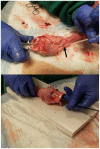A Comprehensive Course for Teaching Emergency Cricothyrotomy
- PMID: 37465596
- PMCID: PMC10332533
- DOI: 10.21980/J8JS9W
A Comprehensive Course for Teaching Emergency Cricothyrotomy
Abstract
Audience: This curriculum was developed for emergency medicine (EM) residents at the post-graduate year (PGY) 1-4 level, and attending EM physicians. It may be adapted for training of any healthcare provider or learner who might be required to perform an emergency cricothyrotomy, including emergency medical technicians, senior medical students, and advanced practice providers (ie, nurse practitioners and physician assistants); however, we did not specifically validate it for these providers.
Introduction: Emergency cricothyrotomy (EC) is a lifesaving surgical procedure, often the option of last resort, used to secure the airway when other methods of airway control have failed or are not feasible. It is a high-risk procedure since it is infrequently performed, but it is time-sensitive and critical for survival when needed.1,2 Time-sensitive procedural skills such as EC are subject to relatively rapid decay,3,4 and unlike other high-risk procedures, in which just-in-time training (JITT) may improve real time procedural performance, the extreme time sensitivity of cricothryotomy precludes JITT as a feasible educational intervention to improve EC performance.5 As such, clinicians must periodically review the essential concepts and practice the physical actions of the procedure in order to build and maintain familiarity with the steps involved and to develop and maintain the muscle memory necessary to perform it quickly and confidently. Previous studies have shown that simulation-based training improves both confidence and competence in the performance of the simulated procedures,6,7 and that small group learning situations are effective for procedural learning.8,9Commercially produced mannequins are available to simulate cricothyrotomy. However, being made of plastic materials, they suffer from unrealistic "tissue" feel that is radically different from that of biologic tissue.10,11 Additionally, because they are mass-produced, they tend to be fairly homogeneous in their anatomic representations, lacking the variability encountered in the human population.We developed an inexpensive procedure simulator using commercially available porcine byproduct that more closely mimics the feel of cricothyrotomy in real life, and a comprehensive curriculum for instruction in, or review of, EC, intended for implementation in a small-group format. This publication is intended to provide interested educators with a comprehensive suite of materials for teaching EC at their own institution. Included are instructions for how to construct the simulator, an EC case scenario with discussion points, a PowerPoint didactic module covering the fundamental concepts of EC, and sample course evaluation forms that may be implemented directly or adapted to meet institutional requirements.
Educational objectives: After completing this activity, the learner will be able to:correctly describe the indications for and contraindications to emergency cricothyrotomycorrectly describe and identify on the simulator the anatomic landmarks involved in emergency cricothyrotomycorrectly list the required equipment and the sequence of the steps for the "standard" and "minimalist" variations of the proceduredemonstrate proper technique when performing a cricothyrotomy on the simulator without prompts or pauses.
Educational methods: Small group activity combining didactic learning, case-based learning, and procedural simulation. The didactic component may be delivered in an asynchronous learning or "flipped classroom" format.
Research methods: The cricothyrotomy simulator was initially pilot-tested on a group of emergency medicine attending faculty, who were asked to evaluate the simulator, with results demonstrating that it was felt to be superior to typical plastic mannequin simulators. This simulator was then subsequently integrated into our airway workshops teaching EC, which include hands-on practice, didactic, and discussion components. The content and delivery of these workshops were assessed by the learners via standardized evaluation forms after completion of each workshop, and the overall clinical relevance, appropriateness of content, and satisfaction with the workshop format were highly rated (mean score 4.87 on a 5-point scale, with 5 denoted as "Excellent").
Discussion: The real-tissue model to simulate the procedure was well liked by course participants, and the learning environment was felt to be conducive to asking questions and discussion. Overall, the instructors and the learners felt that the workshops were effective in improving understanding of the procedure and increasing the comfort level and skill of the emergency physician learners in performing the procedure.
Topics: Cricothyrotomy, cricothyroidotomy, emergency airway, surgical airway, failed airway, rescue airway, can't intubate can't ventilate, small group activity, simulation.
© 2020 Backlund, et al.
Figures






Similar articles
-
Innovations in Airway Education: 3D Printed Neonatal and Pediatric Needle Cricothyrotomy Trainers.J Educ Teach Emerg Med. 2020 Apr 15;5(2):I1-I8. doi: 10.21980/J8R928. eCollection 2020 Apr. J Educ Teach Emerg Med. 2020. PMID: 37465404 Free PMC article.
-
An Innovative Inexpensive Portable Pulmonary Edema Intubation Simulator.J Educ Teach Emerg Med. 2020 Apr 15;5(2):I9-I20. doi: 10.21980/J8MM1R. eCollection 2020 Apr. J Educ Teach Emerg Med. 2020. PMID: 37465400 Free PMC article.
-
Management of Poisoned Patients: Implementing a Blended Toxicology Curriculum for Emergency Medicine Residents.J Educ Teach Emerg Med. 2022 Apr 15;7(2):C1-C32. doi: 10.21980/J8C937. eCollection 2022 Apr. J Educ Teach Emerg Med. 2022. PMID: 37465448 Free PMC article.
-
Prehospital Cricothyrotomy: A Narrative Review of Technical, Educational, and Operational Considerations for Procedure Optimization.J Emerg Med. 2025 Mar;70:19-34. doi: 10.1016/j.jemermed.2024.08.018. Epub 2024 Sep 3. J Emerg Med. 2025. PMID: 39915151 Review.
-
The utility of simulation in medical education: what is the evidence?Mt Sinai J Med. 2009 Aug;76(4):330-43. doi: 10.1002/msj.20127. Mt Sinai J Med. 2009. PMID: 19642147 Review.
Cited by
-
Paramedics Performed Sonographic Identification of the Conic Ligament-A Prospective Controlled Trial.Diagnostics (Basel). 2025 May 21;15(10):1296. doi: 10.3390/diagnostics15101296. Diagnostics (Basel). 2025. PMID: 40428289 Free PMC article.
-
3D printed anisotropic tissue simulants with embedded fluid capsules for medical simulation and training.Sci Adv. 2025 Aug 29;11(35):eadw6446. doi: 10.1126/sciadv.adw6446. Epub 2025 Aug 29. Sci Adv. 2025. PMID: 40880468 Free PMC article.
References
LinkOut - more resources
Full Text Sources
Research Materials
